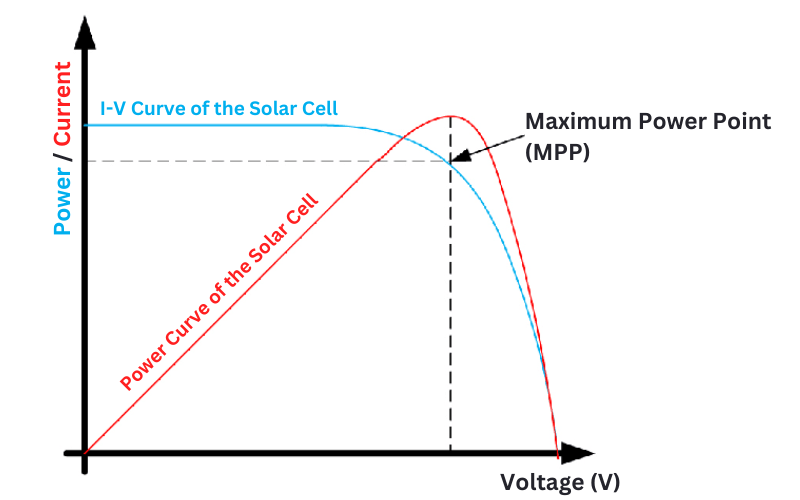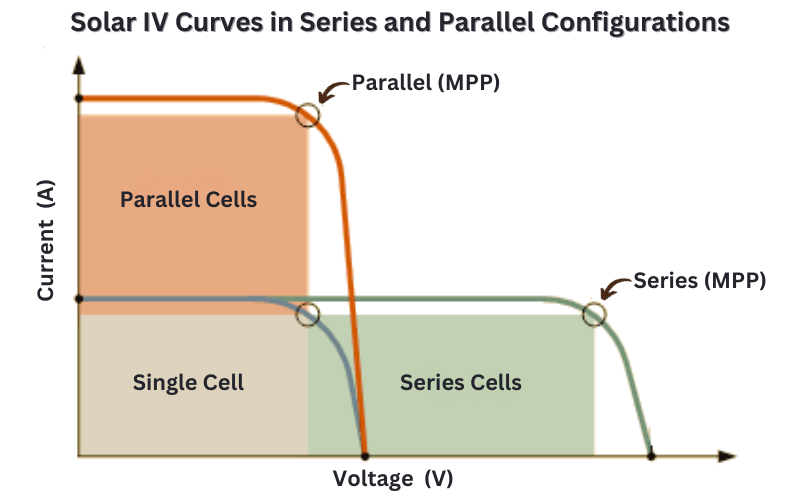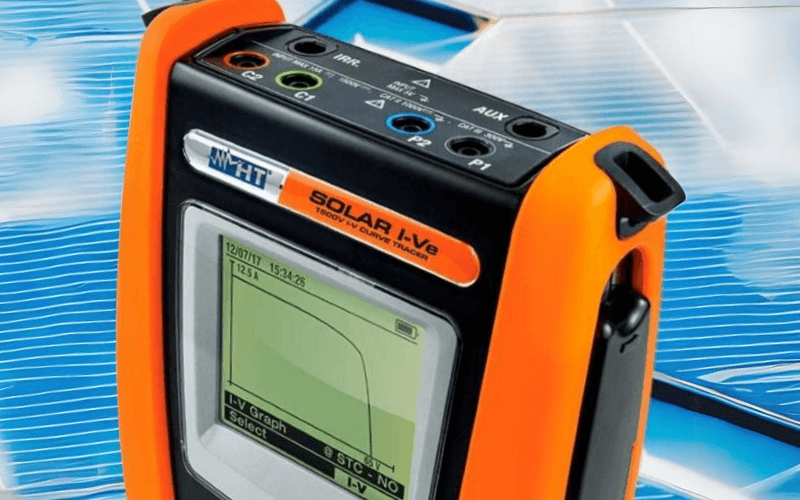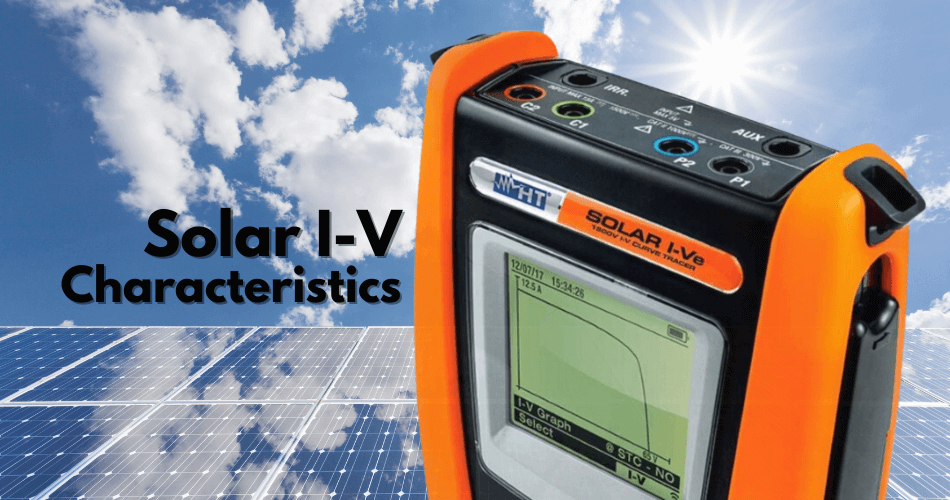The Solar IV (Current-Voltage) Curve is the characteristic curve of a solar cell, which is essential for understanding the performance of a solar cell. It is also used to determine important parameters such as the open-circuit voltage (Voc), the short-circuit current (Isc), the maximum power point voltage (Vmpp), and more.
This piece is tailored for anyone with a penchant for the more technical aspects of solar PV. We’ll dissect the intricacies of solar IV curves, breaking down complex concepts into digestible insights.
Table of Contents
The Fundamentals of Solar IV Curve
Let’s start by demystifying the solar I-V curve. At its core, the I-V curve is a graphical representation depicting the relationship between the current (I) and voltage (V) output of a solar cell under varying environmental conditions. It’s pivotal in evaluating a solar cell’s efficiency and its ability to transmute solar radiation into electrical energy.

Crucial Points on the IV Curve: A Technical Perspective
There are three critical points on the IV curve that merit attention.
- The open-circuit voltage (VOC) signifies the maximum voltage a cell can deliver in an open circuit (Absence of Load).
- The short-circuit current (ISC) represents the peak current achievable when the voltage drops to zero.
- The most crucial of all is the maximum power point (MPP), where the product of current and voltage reaches its apex, indicating optimal power output.
Determining the Maximum Power Point
The maximum power point on a solar power curve is identified through a process that involves maximizing the product of current and voltage. This point is vital because it dictates the most efficient operational state of the solar panel, ensuring maximal power extraction.
Influence of Temperature and Irradiance on IV Curve Dynamics
Temperature and irradiance exert a considerable influence on the morphology of a solar IV curve.
Focusing on temperature’s role, it primarily affects the solar cell’s open-circuit voltage. A rise in temperature typically results in a decrease in VOC, leading to a lowered power output. This phenomenon is attributable to the temperature dependence of the cell’s saturation current, as per the Shockley diode equation.
Conversely, increased irradiance escalates both current and voltage, enhancing power output. The interplay of these elements shapes the IV curve’s characteristics.

Factors Modulating the IV Curve Shape
The shape of a solar IV curve is subject to modification by several external factors. Elements such as irradiation levels, ambient temperature, shading, soiling on the panels, and inherent resistances within the cell (shunt and series resistance) can all impact the curve’s configuration and, by extension, the cell’s efficiency.
Differentiating Solar IV Curve from Solar Power Curve
It’s crucial to distinguish between a solar IV curve and a solar power curve. While they are interrelated, they serve different analytical purposes. The IV curve plots current against voltage, detailing how these variables interact under different conditions.
Integrating Solar IV Curves in Series and Parallel Configurations
In contrast, the power curve concentrates on the relationship between power output (the product of current and voltage) and voltage, highlighting the maximum power point.
Building on our discussion about Solar panel IV Curves, let’s delve into the nuances of stacking these curves when solar cells are configured in series or parallel. Because we know that Solar panels are built by combining cells in series or parallel.
Stacking Solar IV Curves in Series
When solar cells are connected in series, the individual IV curves of each cell combine to modify the overall curve of the array. This series connection is predominantly used to increase the voltage output of the solar array.

Technical Insights:
- Voltage Addition: In a series configuration, the voltages of individual cells add up. The overall curve stretches horizontally, indicating an increased system voltage while maintaining the same current limitation as a single cell.
- Impact on IV Curve: The combined IV curve in a series connection shows a higher open-circuit voltage (VOC), summing up the VOC of each cell. However, the short-circuit current (ISC) remains the same as that of a single cell.
- Shading Considerations: The series connection of IV curves also implies that shading on one cell can disproportionately affect the overall curve, leading to significant power loss.
Stacking Solar IV Curves in Parallel
In parallel connections, solar cells are aligned to enhance the current capacity of the array, with the voltage remaining constant.
Technical Insights:
- Current Summation: The total current output is the sum of the individual cell currents. The overall IV curve in a parallel configuration extends vertically, reflecting an increase in current.
- Alterations in IV Curve: The combined IV curve in a parallel arrangement shows an increased short-circuit current (ISC), aggregating the ISC of each cell, while the open-circuit voltage (VOC) remains unchanged.
- Resilience to Shading: A parallel configuration of IV curves is more resilient to shading effects. If one cell is partially shaded, other cells continue to contribute their full current, lessening the overall impact on the array’s performance.
Applications of Characteristic Curves in Solar Energy Systems
- Performance Analysis: The Solar characteristic curves are critical tools for analyzing the performance and efficiency of solar modules. It aids in identifying the operational health and potential energy yield of the system.
- Optimization of Solar Arrays: By understanding the IV curve and power curve, engineers and designers can optimize solar arrays for maximum energy production, ensuring that the modules operate as close to the MPP as possible.
- Predictive Maintenance: Regular analysis of the power curve can also help in predictive maintenance of solar installations, identifying potential issues before they lead to significant performance drops.
The Role of IV Testers in Solar Cell Analysis
An IV tester, or current-voltage tester, is a sophisticated instrument used to measure the electrical characteristics of solar cells and panels. It plays a pivotal role in assessing a solar cell’s performance by plotting its IV curve.
It bridges the gap between theoretical analysis and practical application, enabling precise measurement and evaluation of solar cell performance.

Key Features of IV Testers:
- Accurate Measurement: IV testers accurately measure the current and voltage output of a solar cell across a range of operating conditions. This precision is crucial for generating reliable IV curves.
- Efficiency Evaluation: Through these measurements, the tester evaluates the efficiency, maximum power point, open-circuit voltage (VOC), and short-circuit current (ISC) of the solar cell.
- Performance Diagnosis: IV testers are invaluable in diagnosing performance issues in solar cells, such as identifying degradation, shading effects, or manufacturing defects.
How IV Testers Work
IV testers function by applying a varying load to a solar cell or panel and simultaneously measuring the current and voltage outputs. This process generates data points that are then plotted to form the IV curve.
Modern IV testers often come with user-friendly interfaces and software that aid in data visualization and analysis, making it easier to interpret the results.
Applications in Solar Technology
- Quality Control in Manufacturing: IV testers are extensively used in the manufacturing of solar cells and panels to ensure product quality and performance standards.
- Installation and Commissioning: They are also crucial during the installation and commissioning of solar systems, ensuring that the panels are functioning optimally.
- Maintenance and Troubleshooting: For ongoing maintenance, IV testers help in identifying performance degradation or faults in the solar system, facilitating timely interventions.
Conclusion
In summary, IV characteristics of a solar cell are not mere graphical representations but are integral in understanding the operational dynamics of solar cells. For students and technical enthusiasts in the field of solar energy, grasping these concepts is essential.
These curves encapsulate the intricate interplay between various physical and environmental factors that dictate the performance of solar cells. Understanding the operation and application of IV testers is also crucial for anyone involved in the solar industry, from research and development to installation and maintenance.
